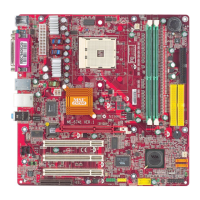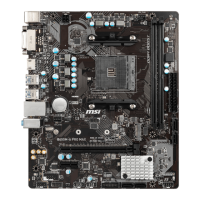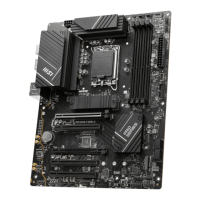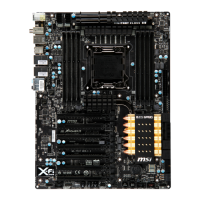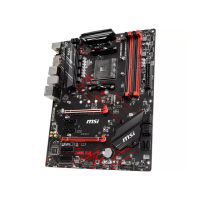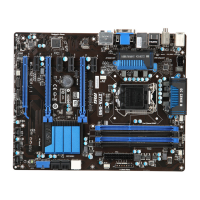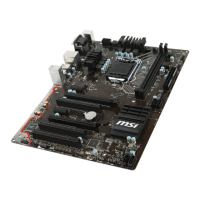Do you have a question about the MSI Intel 500 Series and is the answer not in the manual?
Explains the benefits and improvements offered by UEFI.
Details specific scenarios or hardware that may be incompatible with UEFI.
Provides instructions on locating the current BIOS version on the system.
Instructions on how to access the BIOS setup utility during system boot.
Lists BIOS navigation and control keys, including shortcuts for various functions.
Overview of the simplified BIOS interface for basic settings and system information.
Features for automatic overclocking and performance optimization.
Configuration options for enabling Extreme Memory Profile for enhanced memory performance.
Functions for switching modes, taking screenshots, and searching BIOS options.
Explanation and configuration of the Smart Button and its associated features.
Overview of main menu categories like SETTINGS, OC, M-FLASH.
Access to system, chipset, and boot device parameters.
Settings for CPU and memory overclocking.
Management of overclocking profiles.
Tools for monitoring system voltages and adjusting fan speeds.
Options for setting administrator and user passwords, and TPM settings.
View system information and set system clock and date.
Allows setting the system date and time with specific formats.
Configures PCI and PCI Express interface protocols and latency timers.
Configures PCIe/PCI ASPM state for power saving.
Sets ACPI parameters of onboard power LED behaviors.
Sets integrated peripherals' parameters, such as LAN, HDD, USB and audio.
Sets the operation mode of the onboard SATA controller.
Adjusts integrated graphics settings for optimum system performance.
Sets the thunderbolt device function and configuration.
Sets Windows 10 support level for Thunderbolt devices.
Sets the onboard USB controller and device function.
Sets system Power Management of ErP and AC Power Loss behaviors.
Sets system wake up behaviors for different sleep modes.
Selects the wake up event by BIOS or operating system.
Enables or disables Secure Erase+ function to wipe data from SSD.
Allows system to enter BIOS setup directly by pressing the Power button.
Sets administrator password for system security.
Sets user password for system security with limited rights.
Selects a condition that will request the password (Setup or Boot).
Enables or disables the clear CMOS behavior to clear a set password.
Sets TPM (Trusted Platform Module) function, including device selection.
Records and issues warning messages when the chassis is opened.
Exits BIOS setup without saving any changes.
Saves all changes and reboots the system.
Saves the current configuration changes.
Discards all changes and restores previous values.
Restores or loads all default BIOS values.
Allows selection of a specific boot device for the next startup.
Enables or disables simple or complete version of OC settings.
Sets applied mode for CPU ratio, appearing when CPU supports Turbo Boost.
Sets CPU ratio for determining CPU clock speed.
Sets CPU ratio for a single core, appearing when CPU Ratio Apply Mode is Turbo Ratio.
Sets CPU ratio limits for single and multiple CPU cores.
Configures target CPU Turbo ratio values for different core groups.
Adjusts CPU frequency and individual core ratios for performance.
Selects the CPU Ratio operating mode (Fixed or Dynamic).
Sets CPU power/current parameters; may affect system stability.
Enables or disables Intel Hyper-Threading technology for the CPU.
Allows selection of the number of active CPU cores.
Controls Intel C-State, C1E Support, and Package C State Limit.
Manages Enhanced Intel SpeedStep Technology and Intel Turbo Boost features.
Sets long/short duration TDP power limits and CPU current limits.
Adjusts CPU loadline calibration for voltage stability.
Sets temperature limits for CPU over-temperature protection.
Sets CPU ratio offset for heat dissipation during AVX instructions.
Enables or disables AVX (Advanced Vector Extensions) support.
Sets the ring ratio and displays the adjusted ring frequency.
Sets integrated graphics ratio and displays adjusted GT frequency.
Sets the CPU Base clock, allowing overclocking.
Configures dynamic BCLK search modes and steps.
Enables overclocking technology for memory modules.
Sets DRAM reference clock, gear type, and frequency.
Improves memory compatibility or performance via optimized presets.
Sets memory timings for each/all memory channels.
Detailed settings for various DRAM timing parameters.
Sets the IO latency time for memory channels A and B.
Includes Safe Boot Retry, DRAM Voltage Boost, and Round Trip Latency Optimize.
Adjusts ODT, Rx Equalization, VTT ODT, VDDQ ODT, and Interleave settings.
Configures ODT RTT settings for memory channels.
Enables or disables memory initiation and training for faster booting.
Sets CPU protections for voltage, current, and temperature.
Sets PWM working speed to stabilize CPU Core voltage and minimize ripple.
Enables or disables CPU VRM over temperature protection.
Configures CPU GT voltage, current, and temperature protections.
Sets CPU Core/ GT voltage mode (Auto, Adaptive, Override, Offset).
Configures CPU core voltage and offset modes.
Sets voltage offset values for CPU ratios x25, x35, x43, x48, x50, x51.
Selects the CPU GT voltage offset mode.
Configures CPU SA, IO, PLL, and GT PLL voltages.
Configures DRAM voltage, VTT, VPP, and VREF settings.
Displays detailed information about the installed CPU.
Displays detailed settings and timings of installed memory.
Shows key features supported by the installed CPU.
Details CPU features like CPUID, Virtualization, Hardware Prefetcher, and CFG Lock.
Steps to update BIOS using a USB flash drive via M-FLASH.
Manages overclocking profiles (setting name, saving, loading, clearing).
Saves or loads OC profiles to/from USB flash drive or ROM.
Adjusts fan speed based on CPU/system temperature.
Buttons to set all fans to full speed, default, or cancel changes.
Guides on selecting and adjusting fan duty points for speed control.
Methods to restore default BIOS settings to solve problems.
Procedure for updating BIOS using the M-FLASH utility.
Steps to update BIOS using MSI Center software.
Procedure for updating BIOS using the dedicated Flash BIOS Button.
Information on trademarks, warranty, and rights reserved by MSI.
Details the version and release date of the document.
| Socket | LGA 1200 |
|---|---|
| Memory Support | DDR4 |
| CPU Support | Intel Core 10th Gen, Intel Core 11th Gen, Intel Pentium, Intel Celeron |
| Memory Slots | 4 |
| Memory Speed | Up to 5333 MHz (OC) |
| PCIe Slots | Varies depending on the specific model |
| M.2 Slots | Varies by model (typically 1-3) |
| SATA III | Varies by model (typically 4-6) |
| Storage | M.2, SATA III |
| Audio | Realtek ALC897 Codec |
| LAN | Realtek/Intel Gigabit LAN |
| Form Factor | ATX, Micro-ATX, Mini-ITX (varies by model) |
| Chipset | Intel 500 Series |


